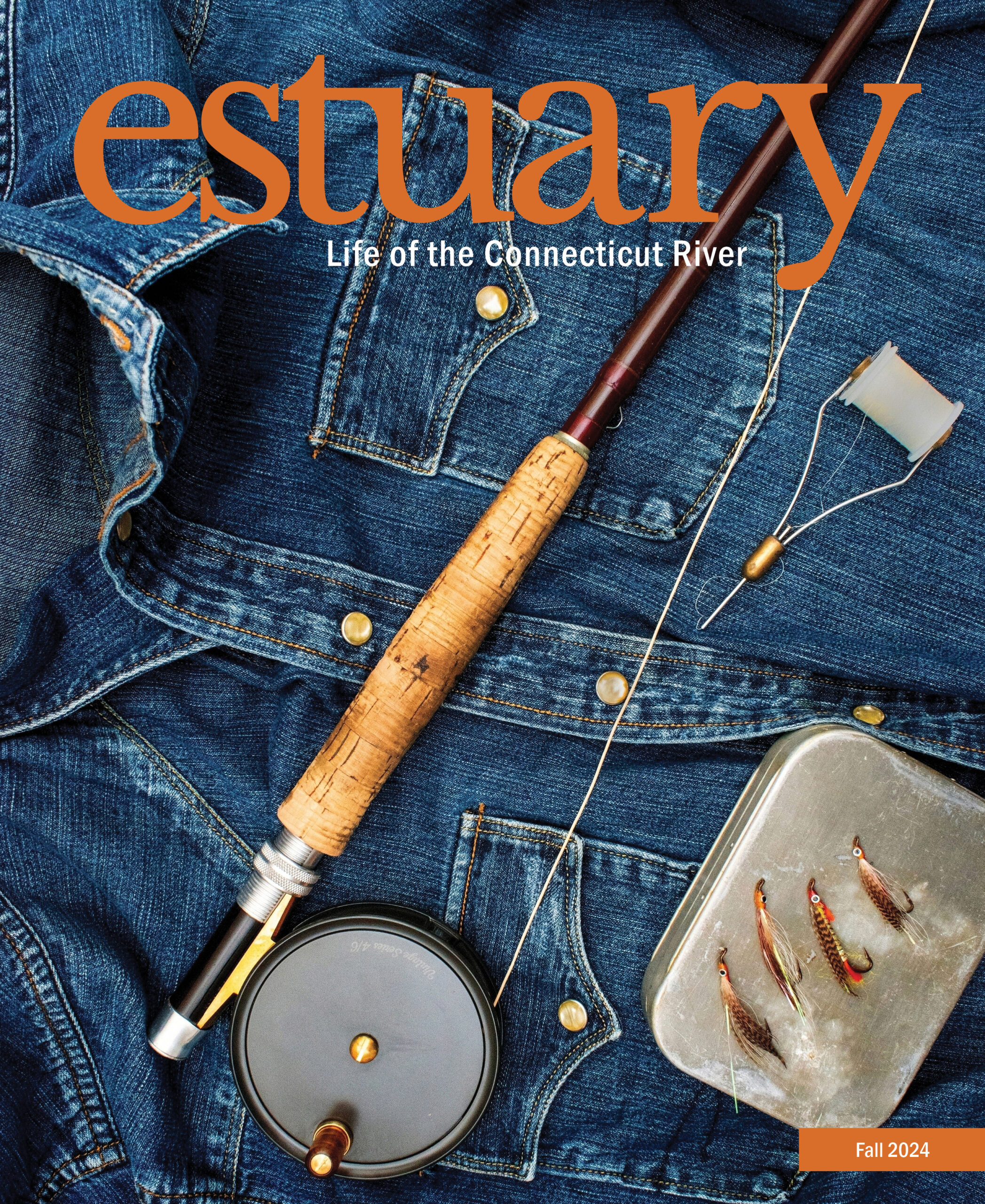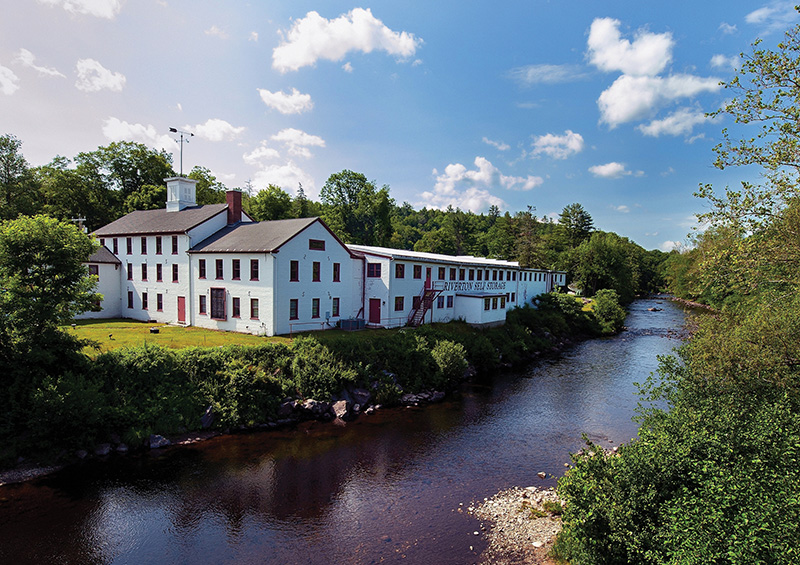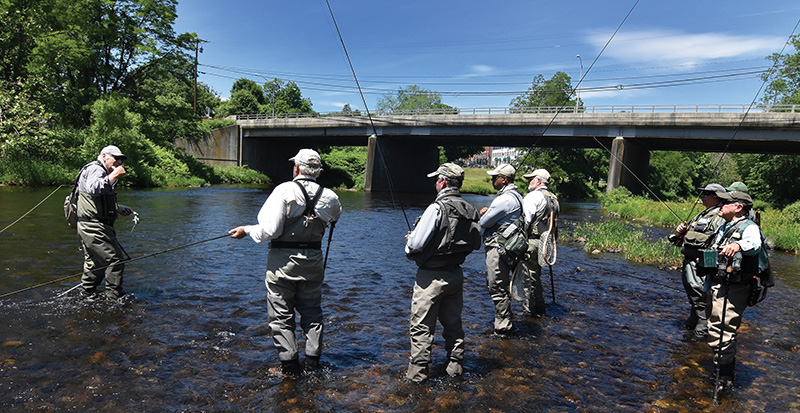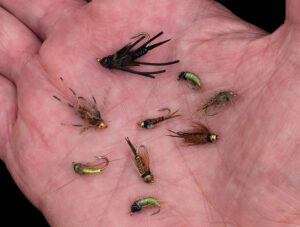 This article appears in the Fall 2024 issue
This article appears in the Fall 2024 issue
 Farmington River, Part Two
Farmington River, Part Two
Story and Photos by Ed Mitchell

The long pool by the former Hitchcock Chair factory in Riverton, part of the Upper “seasonal” Trout Management Area (TMA)
In the previous issue (Summer 2024) we looked at the fabulous dry fly fishing found in the “year-round” Trout Management Area (TMA) on the upper West Branch of the Farmington River in Connecticut. In this issue, we broaden our view, taking in the two other TMAs on the upper Farmington. Given the many miles of water involved, we cannot go into great detail here. Fear not, I have a resource for you: The Farmington River Anglers Association offers their Guide to Fishing the Farmington River. I urge you to pick up a copy. This inexpensive, soft cover publication delivers in-depth advice on the popular spots found in all three TMAs and can be purchased at either of the two shops in the Resources sidebar at the end of the article.
Unlike the “year-round” TMA, these two additional TMAs are “catch & release” during only a portion of the year—from September 1 until 6 a.m. on the second Saturday in April. For this reason, they are called “seasonal” TMAs. The remainder of the year you’re allowed two trout per angler per day with a minimum size of twelve inches, and the use of barbless hooks is never required. The “seasonal” TMAs receive less fishing pressure than the “year-round” TMA, making them attractive alternatives. Both abut the “year-round” TMA, one directly upstream and the other directly downstream. As such, anglers frequently refer to them as the upper and lower “seasonal” TMAs.
The Upper “Seasonal” TMA
The upper “seasonal” TMA begins at the tail end of the Whittemore Pool in Barkhamsted and runs upstream 3.6 miles to the Goodwin Dam, the source of the river’s life-giving cool water. Of the two “seasonal” TMAs, this is the shortest and most scenic, and given its proximity to the dam, hosts the coldest water. Expect hatches to come off later up here than in the “year-round” TMA. It is stocked with almost 10,000 trout each season, half of which are over twelve inches.
East and West River roads offer access as you work your way upstream toward the confluence of the Still River and the tiny village of Riverton where the General Store awaits to refuel you with a sandwich and coffee. Across the street from the store, anglers take advantage of a public parking area. The view from the adjacent bridge reveals a long pool alongside the former Hitchcock Chair factory. It’s a fun spot to fish, but be careful descending the gravel bank.
Continuing upstream, on the east side of the bridge take Route 20 a short distance and then turn left onto Hogback Road. Just ahead on your left is a small pull off in the woods leading to the Beaver Pool. It is a beautiful spot that unfortunately only holds a few anglers. I find the water from here to the dam, though, rarely productive.
The Lower “Seasonal” TMA
The lower “seasonal” TMA originates on the downstream side of the Route 219 bridge in New Hartford and runs nearly thirteen miles before ending at the Route 177 bridge in Unionville. Given its distance from the Goodwin Dam, the lower TMA has the warmest water, which means hatches start and end earlier than in the “year-round” TMA. It is stocked with near 20,000 trout per season, with half being over twelve inches.
From New Hartford, Route 44 parallels this TMA down to Satan’s Kingdom Recreation Area where you’ll find ample parking. Beware, however, this is the launch site for mobs of party loving “tubers” during the warmer weather. From this point the river runs under Route 44, only to reappear a short distance on the east side, down to the confluence of Cherry Brook—a good spot to wet a line.
Immediately ahead at the major intersection, bear onto Route 179 to keep the river in sight into Collinsville. Below the center of town on Route 179, there are a few side streets on your left providing access to the river. Roughly another mile on your left, there is a parking area for the Farmington River Trail system. This public trail hugs the river, allowing for fishing access. A mile more and Route 179 merges with Route 4. In an additional two miles, a larger parking lot is available for the Farmington River Trail system. At this point you’re only a short distance from the Route 177 bridge in Unionville where this TMA ends.

Fly fishing class at the Route 219 bridge in New Hartford.
Twenty-Two Miles of Fishing
Together the three TMAs offer twenty-two miles of prime water—a lifetime of wonderful angling. The trout numbers per mile are excellent, and natural reproduction occurs especially in the “year-round” TMA where nearly half the brown trout are wild.
How to best fly fish these TMAs is, of course, your decision. In the Summer 2024 issue I highlighted dry fly fishing, but hatches occur only a small percentage of the time. Day in and day out, month in and month out, trout feed mainly underwater, so from a purely pragmatic point of view, fishing subsurface flies—nymphs, wet flies, soft hackles, and streamers—makes abundant sense. Refining it a step further, I think fishing nymphs is the single most productive method. Whether you opt to do it with a “strike indicator” or prefer “euro-nymphing,” it doesn’t truly matter. Both methods present flies matching mayfly nymphs, caddis pupae, and other aquatic insects close to the bottom moving naturally with the current. Should either of these “nymphing” techniques be new to you, you can find a wealth of instructional videos on YouTube.

May fly, caddis pupae, and stonefly nymphs.
Final Notes
- Growing numbers of black bears exist in rural Connecticut. Although I have never heard of a bear interacting with an angler, if you travel the river in low light, carrying a can of bear spray is not a bad idea.
- Small amounts of Didymo, often called “rock snot,” exist. If you wade into it, upon getting home kill it by placing your boots in the freezer for 24 hours.
Ed Mitchell is the author of four books about fly-fishing and has written for many magazines. He has over forty years of experience in both fresh and saltwater fly-fishing. The author thanks veteran Farmington River guide Bruce Marino for his help with the hatches.
Resources
Guide to Fishing the Farmington River
(Farmington River Anglers Association, 1995)
Available at the stores listed below.
Upcountry Sportfishing
352 Main Street, New Hartford, CT
860-379-1952, Facebook and Instagram
Gear, great selection of flies, guides, classes, and invaluable advice
Orvis Shop
380 West Main Street, Avon, CT, 860-678-7900
Fly gear, flies, classes, advice, and the latest Orvis tackle
Parrott Delaney Tavern
37 Greenwoods Road, New Hartford, CT
860-379-0188, ParrottDelaneyTavern.com
